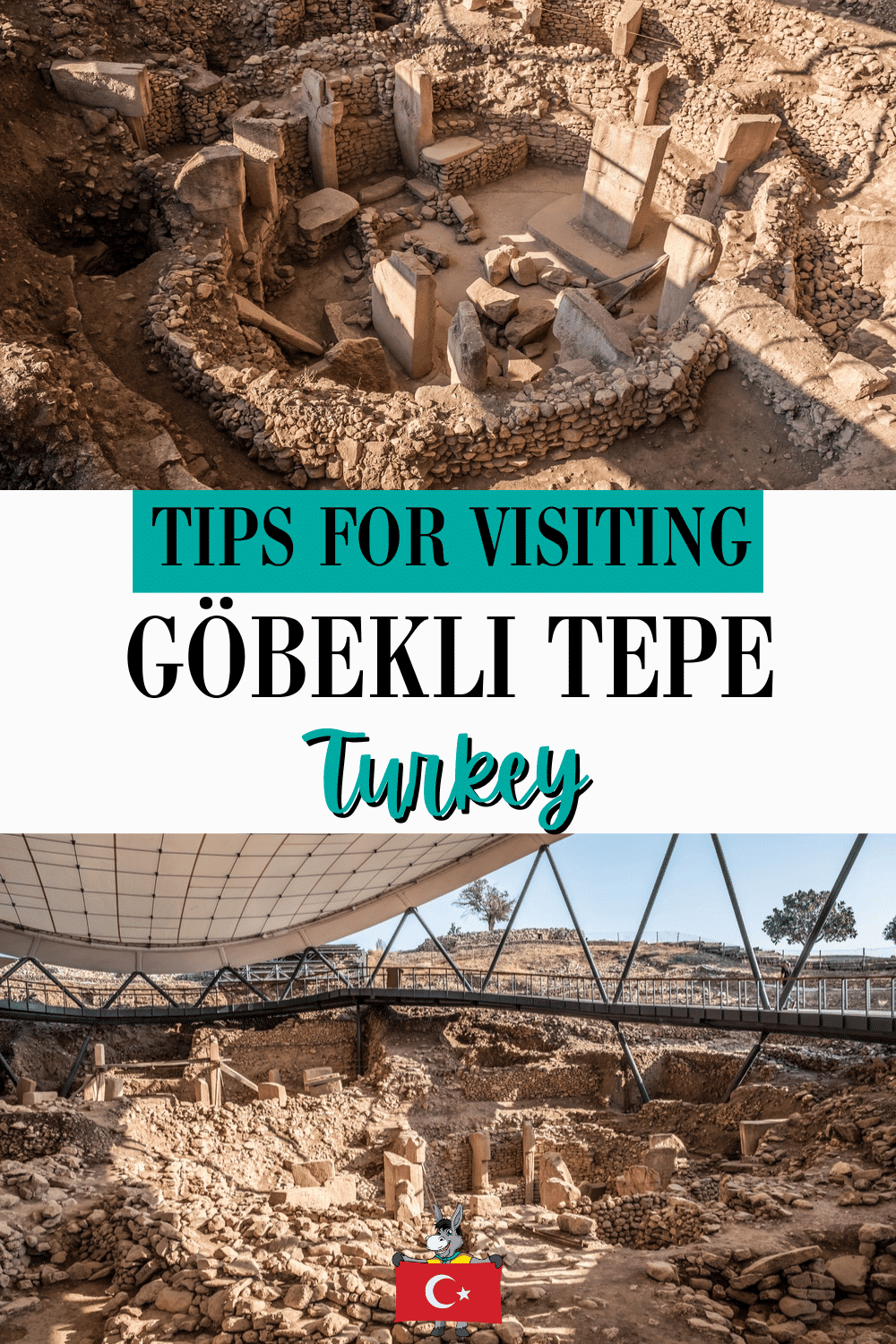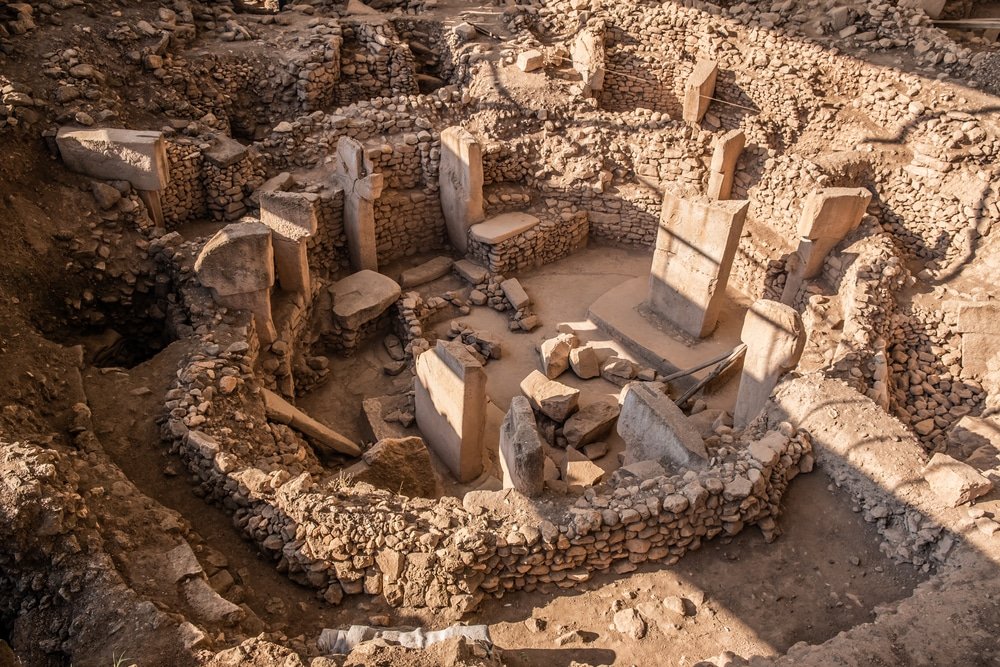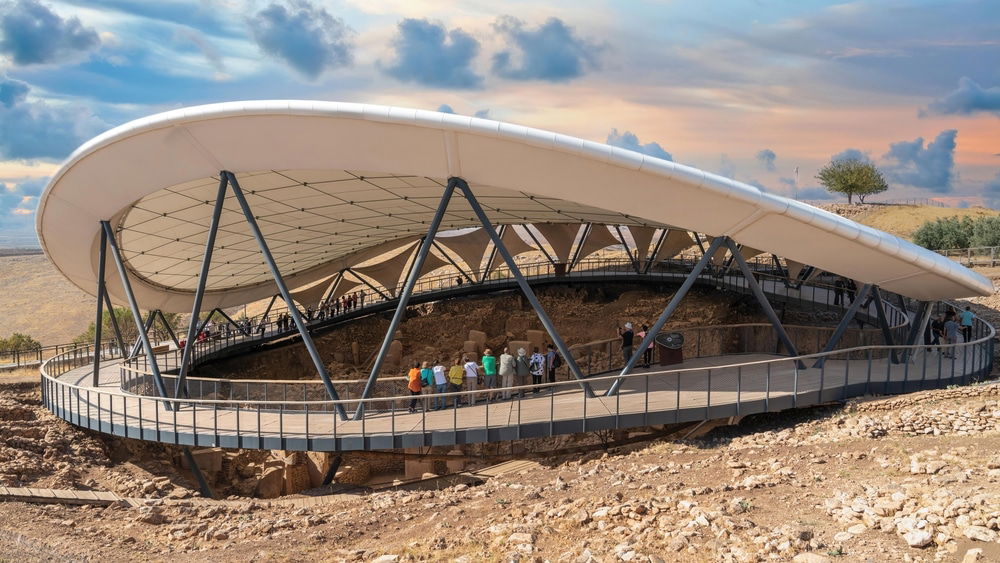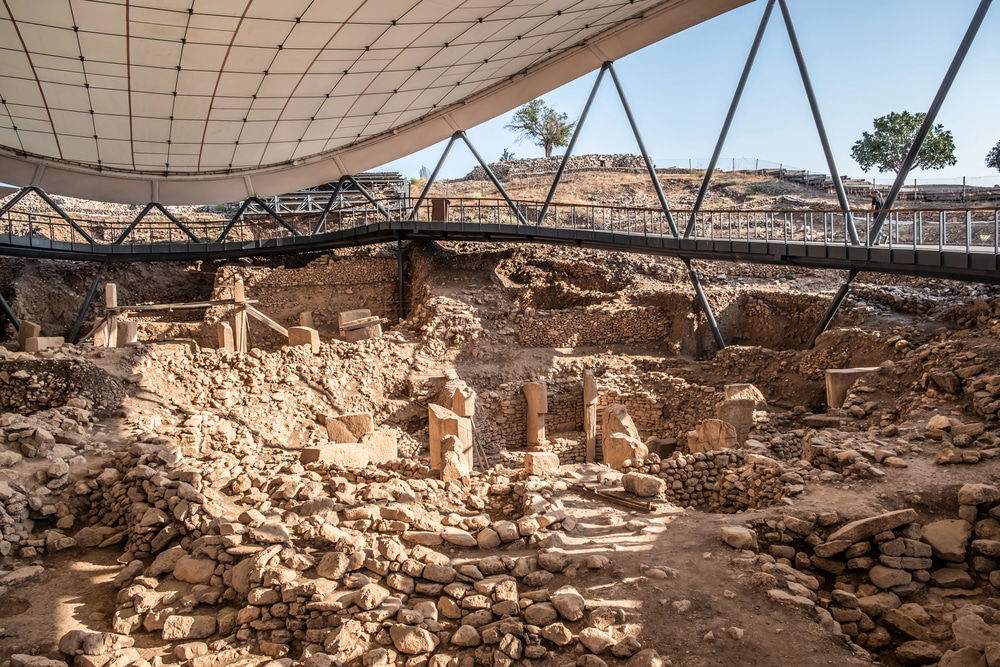Göbekli Tepe, often referred to as one of the most significant archaeological discoveries in the world, is a million miles away from the Turkish beach resorts you might be used to. But, in all honesty, it’s a must-visit and my guide will explain you everything you need to know about the site.

Skip Ahead To My Advice Here!
Visit Gobekli Tepe

Located in southeastern Turkey, this prehistoric site dates back over 11,000 years, making it the oldest known temple complex on the planet. Its discovery has wholly reshaped our understanding of human history, particularly regarding the origins of religion, architecture, and community life.
In 2019, Göbekli Tepe was designated as a UNESCO World Heritage site, solidifying its importance not just as a national treasure for Turkey but as a pivotal key to humanity’s past recognized globally.
The site comprises large circular enclosures, some measuring over 20 meters in diameter, constructed from carefully crafted limestone pillars that reach heights of up to 5.5 meters (18 feet). Interestingly, many of these stones are adorned with intricate carvings of animals, including foxes, wild boars, and birds, which hint at the spiritual or ceremonial significance they held for the people of the time.
The sheer scale and age of the site are mind-blowing, pushing you back into a world that predates even Stonehenge or the Great Pyramids of Giza. Walking through this ancient sanctuary allows you to contemplate the beginnings of human civilization and the abstract thoughts that might have occupied the minds of its creators.
Note: In this document, you’ll see both “Göbekli Tepe” and “Göbeklitepe” used interchangeably to reflect the variations in spelling commonly found in English and Turkish contexts.
Göbekli Tepe Is Known As The Greatest Archaeological Site

Göbeklitepe was discovered in the 1960s, but detailed exploration didn’t begin until the mid-1990s. This archaeological marvel has transformed our understanding of prehistoric human life. The site is estimated to be around 12,000 years old, dating back to the Pre-Pottery Neolithic period. It signals not just the advent of agriculture but suggests sophisticated societal structures and ceremonial practices long before the emergence of settled farming communities.
The discovery of Göbeklitepe is also pretty interesting. Initially, its significance was underappreciated, as excavators presumed it was merely a burial mound. However, paleontologist Klaus Schmidt, who led the excavation efforts, recognized its extraordinary potential.
Layers of limestone pillars adorned with intricate carvings of animals and abstract symbols revealed a complex, monumental sanctuary. Over 20 stone t-shaped pillars, many of which stand over 5 meters tall, have been uncovered and arranged in circular enclosures that suggest a communal gathering place. The enormity of the structures, alongside their craftsmanship, sparked intrigue and pushed people to explore further.

The significance of Göbeklitepe extends beyond its stunning architecture; it plays a pivotal role in rethinking how early humans lived and organized themselves. Before its discovery, many believed that the development of agriculture came first, leading to settled communities that allowed for the construction of large-scale religious structures. Göbeklitepe, however, flips this narrative on its head.
It suggests that building such a massive complex came from communal ritualistic needs while social cohesion was already in place, predating agriculture. It tells us that social complexity and religious practices may have developed independently of food cultivation rather than as a direct result of it.
Without written records, the carvings and layout tell us about the spiritual beliefs of the community at the time. The decorations include various animals, from snakes to foxes and birds, possibly related to animism or the reverence of nature’s forces. This suggests that religion and spirituality were integral to human existence.
The site also tells us a lot about the community at the time. The act of gathering to build, worship, and celebrate suggests a dynamic social network. The care taken in the construction of Göbeklitepe tells us that those who built it possessed not only the practical skills required for architecture but also a deep connection to the spiritual aspects of their lives.
There’s more.
Göbeklitepe hints at a type of social hierarchy during a time thought to be simple hunter-gatherer bands. The site’s complexity tells us that some form of leadership or organization was required to allow for the collaboration needed to construct such a huge structure. This reshapes our understanding of power dynamics and social structures in prehistoric communities.
Unsurprisingly, the archaeological site garnered significant international attention and protection and was add to theUNESCO World Heritage list in 2019.
In the end, Göbeklitepe is much more than a set of ancient stones; it represents a radical rethinking of the origins of human civilization, a complex ceremonial hub that suggests spirituality and social cohesion were central to human life long before agriculture dominated. It throws everything we thought we knew on its head.
Brands We Use And Trust
Must Visit Sights In Gobekli Tepe
Göbeklitepe is vast, so it’s a good idea to know what to look for before you get there. Let’s talk about some highlights.
The Main Enclosure (Temenos)

At the heart of Göbeklitepe lies the Main Enclosure, often referred to as the “temenos.” This circular structure is a breathtaking sight, characterized by T-shaped limestone pillars that soar high, some reaching up to 5.5 meters. The largest of these megaliths, which weigh several tons, is an awe-inspiring feat of engineering that says a lot about the organizational abilities of the people who built it.
The pillar carvings feature abstract symbols, animals such as snakes, foxes, and birds, indicating the deep spiritual beliefs of a society in tune with nature. Standing inside the enclosure, you can’t help but feel connected to ancient rituals that likely took place there.
The Visitor Centre
Before diving into the ruins, a stop at the Göbeklitepe Visitor Centre is a must. This modern facility features interactive displays, informative panels, and multimedia presentations that provide insight into the spiritual and cultural significance of the site.
The center also houses artifacts and a scale model of the site itself, helping you grasp the size of Göbeklitepe before you explore it.
You can also take guided tours, which will give you a greater understanding of the site’s history and context.
The Varied Enclosures
One of the most striking features of Göbeklitepe is the number of different enclosures that have been uncovered. While Enclosure A and Enclosure B are the most famous, each presents a unique vision of the past.
Enclosure B features a circular design that is slightly smaller than Enclosure A but equally fascinating. Each enclosure is a unique puzzle piece that gives clues about the social and religious practices of prehistoric communities.
The Animal Carvings
As you wander through the site, be sure to take a closer look at the intricate animal carvings adorning the pillars. These sculptures have captivated archaeologists and visitors alike for their careful detail.
Often interpreted as totems or representations of clans, the animals — including lions, birds, and snakes — are not only decorative elements but are believed to hold significant meaning in the context of ancient beliefs.
The Surrounding Landscape
Göbeklitepe is nestled within a picturesque landscape that features rolling hills and fields that stretch towards the horizon. The site itself is set on a hilltop, providing panoramic views of the region. This setting is not just beautiful; it also allows you to feel like you’re right back in the time the Neolithic people existed. You can appreciate the fertile plains that may have served as hunting grounds and gathering areas for the communities that constructed the temples.
Plus, this entire area is a must for your camera.
The Archaeological Excavation Areas
Parts of Göbeklitepe are still being excavated as an active archaeological site. It’s fascinating to observe ongoing excavation work, which offers a unique glimpse into the process of uncovering history. Guided tours provide insights from archaeologists about the methods used and the discoveries being made. You might even be fortunate enough to see newly unearthed artifacts or structures that add to the story of this remarkable site.
The Sacred Symbols
Beyond the animal carvings, Göbeklitepe is filled with many sacred symbols that leave a lasting impression. These abstract carvings, thought to represent cosmic ideals or spiritual beliefs, speak volumes about the conceptual world of the Neolithic people. Efforts to understand these symbols are still ongoing, and you have to wonder whether we’ll ever truly understand.
Guided Tours
I mentioned guided tours briefly, and they are one of the best ways to experience Göbeklitepe fully.
Knowledgeable local guides offer invaluable insights that bring the site to life in ways that self-exploration simply cannot. Their passion for the history and culture of Göbeklitepe is infectious, encouraging you to ask questions and dive deeper into this ancient site.
Tips For Visiting Gobeklitepe
To make the most of your journey, here are some practical tips:
How To Get To Göbekli Tepe From Sanlıurfa
The nearest airport to Göbeklitepe is Şanlıurfa Airport (SFQ), which is roughly 40 kilometers away from the archaeological site. Regular Turkish Airlines domestic flights connect Şanlıurfa to major cities like Istanbul and Ankara, making it relatively easy to fly in.
Transportation From Şanlıurfa To Göbeklitepe
Car rental
Upon arriving at the airport, you have the option of renting a car. The drive from Şanlıurfa to Göbeklitepe usually takes about 45 minutes via the D850 highway. This method offers you the flexibility to explore the surrounding areas at your own pace.
Taxis
Another convenient option is to take a taxi directly to Göbeklitepe. Taxis are available from the airport and throughout Sanliurfa. Always ask for the meter to be turned on to ensure fair pricing.
Public transport
While public transport options like minibusses may not be as direct or comfortable, they are available and can provide a budget-friendly way to reach Göbeklitepe. From Şanlıurfa’s main bus station, minibusses head towards the site. Travel time may vary, but it can take up to an hour or more, depending on stops.
Organized Tours
For a stress-free experience, consider joining an organized tour to Göbeklitepe. Many local travel agencies in Şanlıurfa offer guided tours of the site, often including a knowledgeable guide who can provide invaluable insights into its history and significance. These tours typically include transportation from your hotel, ensuring a hassle-free visit.
When Is The Best Time To Visit Göbeklitepe
Ideally, the best times to visit are during the spring (April to June) and autumn (September to November). During these seasons, you will enjoy pleasantly mild temperatures, typically ranging from the mid-20s to the low 30s Celsius (70s to 80s Fahrenheit). This climate not only makes it easier to explore but also allows you to appreciate the surrounding natural beauty fully.
The summer and winter months in this region can be very hot and cold, respectively. That’s why shoulder seasons are a much more comfortable time to explore.
To avoid the crowds, aim to arrive early in the morning, right when the site opens, or later in the afternoon, close to closing time. These times are not only less crowded but also feature softer, golden lighting that’s ideal for photography.
Remember to wear comfortable walking shoes and a hat, especially if you visit in warmer months. You’ll want to spend several hours wandering through this fascinating site.
Visiting Gobekli Tepe FAQs
What is Göbekli Tepe?
Göbeklitepe is an ancient archaeological site in southeastern Turkey. It is considered one of the world’s oldest known temples. Dating back to around 9600 BCE, it features massive stone pillars arranged in circles, suggesting early human rituals or gatherings.
Why is Göbeklitepe important?
Göbeklitepe holds immense historical significance as it predates Stonehenge and the Pyramids of Giza. It provides insights into prehistoric human societies, religion, and the transition from nomadic lifestyles to settled agriculture.
Who discovered Göbeklitepe?
The site was first discovered in the 1960s by a team of archaeologists led by essential figures like Klaus Schmidt, who began extensive excavations in 1994 that revealed its significance.
What are the main features of Göbeklitepe?
The site includes T-shaped limestone pillars, some over 5 meters tall, engraved with animal carvings, such as foxes, birds, and snakes. The design suggests a complex social structure and shared beliefs among early humans.
How was Göbeklitepe constructed?
The exact methods remain a mystery, but the construction required sophisticated knowledge of quarrying and stonework. It’s believed that a large workforce, possibly consisting of hunter-gatherers, collaborated to create the site.
Was Göbeklitepe used for worship?
While the primary function is not definitively known, many scholars believe Göbeklitepe was a ceremonial site, possibly linked to rituals or communal gatherings. It represents humanity’s early expressions of spirituality.
What does “Göbeklitepe” mean?
The name “Göbeklitepe” translates from Turkish to “Potbelly Hill,” which describes the site’s mound-like shape, which contains numerous layers of ancient structures.
Is Göbeklitepe open to visitors?
Yes! Göbeklitepe is open to the public, and facilities, including a visitor center, provide information and context about the site. It is advisable to check for any visitor guidelines or restrictions beforehand.
How can I get to Göbeklitepe?
Göbeklitepe is located near the city of Şanlıurfa. It can be reached by car, bus, or guided tour from major cities in Turkey. The site is well-signposted and offers ample facilities for visitors.

